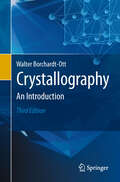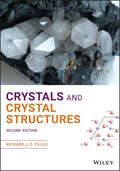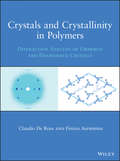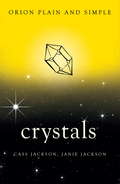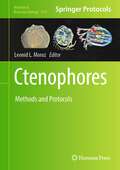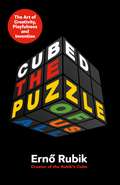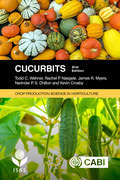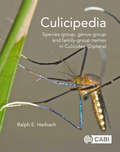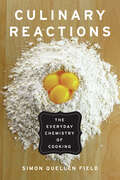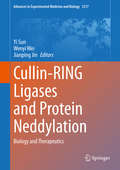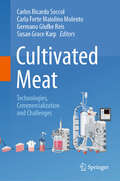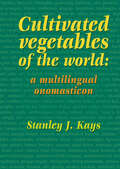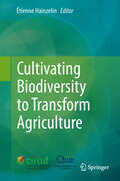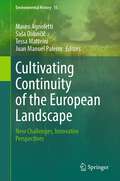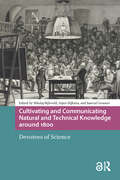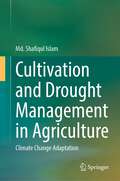- Table View
- List View
Crystallography: An Introduction
by Walter Borchardt-Ott Robert O. GouldAs a self-study guide, course primer or teaching aid, Borchardt-Ott's Crystallography is the perfect textbook for students and teachers alike. In fact, it can be used by crystallographers, chemists, mineralogists, geologists and physicists. Based on the author's more than 25 years of teaching experience, the book has numerous line drawings designed especially for the text and a large number of exercises - with solutions - at the end of each chapter. This 3rd edition is the translation of the seventh German edition with new chapters focused on crystal chemistry and x-ray diffraction methods.
Crystals and Crystal Structures
by Richard J. TilleyAn authoritative, updated text that offers an introduction to crystals and crystal structure with coverage of crystallography, and microscopy of materials Written in a friendly, non-mathematical style, the updated second edition of Crystals and Crystal Structures offers a comprehensive exploration of the key elements of crystals and crystal structures. Starting with the basics, it includes information on multiple areas of crystallography, including modulated structures, quasicrystals and protein crystallography, and interdisciplinary applications as diverse as the relationship between physical properties and symmetry. To enhance comprehension of the material presented, the book contains a variety of problems and exercises. The revised second edition offers new material and updates in the field including: An introduction to the use of high intensity X-ray analysis of protein structures Advances in imaging, scanning electron microscopy, and cryo-electron microscopy The relationship between symmetry and physical properties highlighting new findings and an introduction to tensor notation in describing these relationships in a concise fashion Nanoparticles as well as crystallographic aspects, defects, surface defects and the impact of these crystallographic features on properties Perovskite structures and their variations and the inclusion of their wide-ranging properties Written for students ofcrystallography, chemistry, physics, materials science, biosciences and geology, Crystals and Crystal Structures, Second Edition provides an understanding of the subject and enables students to read scientific papers and articles describing a crystal structure or use crystallographic databases.
Crystals and Crystallinity in Polymers
by Finizia Auriemma Claudio De RosaProvides the tools needed to master and apply the fundamentals of polymer crystallographyUsing core concepts in physics, chemistry, polymer science and engineering, this book sheds new light on the complex field of polymer crystallography, enabling readers to evaluate polymer crystallization data and determine the best methods to use for their investigations. The authors set forth a variety of tested and proven methods for analyzing ordered and disordered structures in polymer crystals, including X-ray diffraction, electron diffraction, and microscopy. In addition to the basics, the book explores several advanced and emerging topics in the field such as symmetry breaking, frustration, and the principle of density-driven phase formation.Crystals and Crystallinity in Polymers introduces two new concepts in crystallinity and crystals in synthetic polymers. First, crystallinity in polymeric materials is compatible with the absence of true three-dimensional long-range order. Second, the disorder may be described as a structural feature, using the methods of X-ray scattering and electron diffraction analysis.The book begins by introducing the basic principles and methods for building structural models for the conformation of polymer crystal chains. Next, it covers:Packing of macromolecules in polymer crystalsMethods for extracting structural parameters from diffraction dataDefects and disorder in polymer crystalsAnalytical methods for diffuse scattering from disordered polymer structuresCrystal habitInfluence of crystal defects and structural disorder on the physical and mechanical properties of polymeric materialsCrystals and Crystallinity in Polymers examines all the possible types of structural disorder generally present in polymer crystals and describes the influence of each kind of disorder on X-ray and electron diffraction patterns. Its comprehensive, expert coverage makes it possible for readers to learn and apply the fundamentals of polymer crystallography to solve a broad range of problems.
Crystals: The Only Book You'll Ever Need (Plain And Simple Ser.)
by Cass Jackson & Janie JacksonFrom time immemorial, crystals have been used for healing, and legend has it that long ago, people knew how to store information inside these precious stones. How does their incredible magic work? Through this clear, practical guide, discover the many ways crystals can cure physical, emotional, and spiritual problems, divine the future, and enhance psychic powers. See which ones work best to aid meditation and visualisation, clear a room of negative energy, promote creativity, or foresee the future. There's advice on buying, purifying, and charging the stones, crystal folklore, and a breath-taking gallery rich in information.
Ctenophores: Methods and Protocols (Methods in Molecular Biology #2757)
by Leonid L. MorozThis volume explores emerging approaches and methods inspired by recent research using ctenophores or placozoans, facilitating the study of these enigmatic species and ancient animal lineages. Practical protocols are integrated with introductory chapters about general biology, summarizing the diversity, evolution, genomics, development, and neurobiology of these organisms. Special chapters outline strategies and applications for culturing, microscopy, physiology, electrical synapses, and bioluminescence, molecular and single-cell biology, transcription factors, as well as gene and protein expression analyses. The book also contains bioinformatics and computational chapters covering peptidomics and epigenomics. Written for the highly successful Methods in Molecular Biology series, chapters include detailed implementation advice that leads to dependable results in the laboratory. Authoritative and practical, Ctenophores: Methods and Protocols is anideal resource for comparative and experimental biologists and interdisciplinary scientists aiming to decipher fundamental principles of animal organization, origin, and the evolution of biological complexity in general, opening novel avenues for future synthetic biology research.
Ctrl + Z: The Right to Be Forgotten
by Meg Leta JonesA gripping insight into the digital debate over data ownership, permanence and policy“This is going on your permanent record!” is a threat that has never held more weight than it does in the Internet Age, when information lasts indefinitely. The ability to make good on that threat is as democratized as posting a Tweet or making blog. Data about us is created, shared, collected, analyzed, and processed at an overwhelming scale. The damage caused can be severe, affecting relationships, employment, academic success, and any number of other opportunities—and it can also be long lasting. One possible solution to this threat? A digital right to be forgotten, which would in turn create a legal duty to delete, hide, or anonymize information at the request of another user. The highly controversial right has been criticized as a repugnant affront to principles of expression and access, as unworkable as a technical measure, and as effective as trying to put the cat back in the bag. Ctrl+Z breaks down the debate and provides guidance for a way forward. It argues that the existing perspectives are too limited, offering easy forgetting or none at all. By looking at new theories of privacy and organizing the many potential applications of the right, law and technology scholar Meg Leta Jones offers a set of nuanced choices. To help us choose, she provides a digital information life cycle, reflects on particular legal cultures, and analyzes international interoperability. In the end, the right to be forgotten can be innovative, liberating, and globally viable.
Cuatro Ciénegas Ecology, Natural History and Microbiology (Cuatro Ciénegas Basin: An Endangered Hyperdiverse Oasis)
by Valeria Souza Gabriela Olmedo-Álvarez Luis E. EguiarteThe aim of this first book is to introduce the readers of the series to why Cuatro Ciénegas Basin (CCB) is so unique, starting with the reason why astrobiologists became interested in this oasis in the first place; namely, the high diversity and abundance of stromatolites and microbial mats in continental waters to be found in the desert oasis. As NASA has long since discovered, the basin may offer the best analog of early Earth. In essence, CCB is a time machine that can take us far back and forth in time. In the respective chapters, the contributing authors explain the extraordinary microbial diversity of Cuatro Ciénegas Basin from various perspectives. In order to do so, they explain their journey as well as the different tools used to unravel the basin’s mysteries, such as: Why are there so many species in a place without food? How has life there survived the enormity of tectonic shifts through the ages, maintaining its ancient marine heritage?
Cuba After Castro: Legacies, Challenges, and Impediments
by Bruce Hoffman Kevin F. Mccarthy Gabriella Gonzalez Louay Constant Edward Gonzalez Jeffery C. TannerWhen the end of the Castro era arrives, the successor government and the Cuban people will need to answer certain questions: How is Castro's more than four-decade rule likely to affect a post-Castro Cuba? What will be the political, social, and economic challenges Cuba will confront? What are the impediments to Cuba's economic development and democratic transition? The authors examine Castro's political legacies, Cuba's generational and racial divisions, its demographic predicament, the legacy of a centralized economy, and the need for industrial restructuring.
Cubed: The Puzzle Of Us All
by Erno RubikErno Rubik inspires us with what he's learned in a lifetime of creating, curiosity, and discovery.
Cubeo Hehénewa Religious Thought
by Peter Wilson Irving IrvingThe societies of the Vaupés region are now among the most documented indigenous cultures of the New World, in part because they are thought to resemble earlier civilizations lost during initial colonial conflict. Here at last is the eagerly awaited publication of a posthumous work by the man widely regarded as the preeminent authority on Vaupés Amazonian societies. Cubeo Hehénewa Religious Thought will be the definitive account of the religious worldview of a significant Amazonian culture. Cubeo religious thought incorporates ideas about the nature of the cosmos, society, and human life; the individual's orientation to the world; the use of hallucinogenic substances; and a New World metaphysics. This volume was substantially completed before Irving Goldman’s death, but Peter Wilson has edited it for publication, providing a thorough introduction to Goldman’s work. Stephen Hugh-Jones has contributed an afterword, setting the work in the context of contemporary Vaupés ethnography.
Cucurbits (Crop Production Science in Horticulture)
by Professor Todd C Wehner Dr Rachel P. Naegele Professor James R. Myers Dr Narinder P Dhillon Professor Kevin CrosbyCompletely updated with new content and full-colour figures throughout, the second edition of this successful book continues to provide complete coverage relating to the production of cucurbits, including cucumbers, gourds, muskmelons, pumpkins, squashes and watermelons. These crops are grown worldwide and represent one of the largest and most important groups of horticultural food plants. This second edition of Cucurbits provides up-to-date, succinct and authoritative knowledge on this variety of crops and reflects on significant advances in the areas of production, breeding and evolution. This new edition: - Contains new chapters on abiotic stresses and cucurbits for health - Includes major updates in research on the evolution, movement and distribution of species - Explores new genetic resources and breeding advancements - Delivers current information on methods of improving yield (e.g. grafting) and the management and resistance for pests and diseases - Has an updated list of the most recent taxonomic names This book represents a current and comprehensive guide to cucurbits, is highly illustrated and written in an accessible style. It is an essential resource for students, growers and researchers.
Culicipedia: Species-group, genus-group and family-group names in Culicidae (Diptera)
by Ralph E. HarbachMosquitoes are undeniably one of the most studied groups of insects due to their great impact on human health as the agents that transmit the pathogens which cause malaria, filariasis and numerous viral diseases, such as yellow fever and dengue fever. The study of mosquitoes has given rise to a plethora of names for subspecies, species, subgenera, genera and family-level groups, many of which are duplicate names for the same entity. This unique volume is a comprehensive compilation of all scientific names introduced at all levels of classification within the family since the official start of zoological nomenclature. The work is largely a lexicon that is historical and informative as well as nomenclatural and bibliographic. Unlike catalogues, it contains sections devoted separately to the groups of names regulated by the International Code of Zoological Nomenclature, the species, genus and family groups, as well as sections concerned with names derived from personal and geographical names and other sources. In addition to insights into the history of mosquito classification, attention given to the formation, latinization and derivation of names makes the work a crucial contribution to mosquito science. Culicipedia is an important comprehensive reference source for students, entomologists, professional taxonomists and other scientists interested in culicid nomenclature, classification and the etymology of scientific names.
Culinary Man and the Kitchen Brigade: Normative Subjectivity in Western Fine Dining Traditions (Routledge Food Studies)
by Jordan FallonCulinary Man and the Kitchen Brigade offers an exploration of the field of normative subjectivity circulated within western fine dining traditions, presenting a theoretical analysis of the governing relationship between the chef, who embodies the Culinary Man, and the fine dining brigade.The book offers a unique treatment of western haute cuisine’s interlocking regime of labor and aesthetics and theorizes the underexplored kitchen brigade as a model of disciplinary formation. It deploys a heterogeneous set of disciplinary discourses and practices which have the effect of consolidating monopolies on epistemic authority and governance. Each position within the brigade’s hierarchy is subject to distinct, though related, disciplinary practices. Thus, chapters identify the specific practices pertinent to each brigade subject, while also illuminating how they fit together as a coherent hegemonic project. The application of Wynterian and Foucauldian insight to the fine dining brigade offers a political theory of culinary work which departs from other food studies texts. Notably, this work offers an in-depth treatment of the brigade’s colonial dimensions which resonate with emerging critiques, scholarly and general, of the race and gender politics of restaurant labor. The concluding chapters seek to identify where extant modes of resistance or alternative forms of culinary organization may hold the potential to move beyond the hegemonic overrepresentation of Culinary Man.This book will be of great interest to students and scholars from across the social sciences and humanities interested in critical food studies, political and cultural theory, and popular culinary culture.
Culinary Reactions: The Everyday Chemistry of Cooking
by Simon Quellen FieldExploring the scientific principles behind everyday recipes, this informative blend of lab book and cookbook reveals that cooks are actually chemists. Following or modifying recipes is shown to be an experiment with acids and bases, emulsions and suspensions, gels and foams. This easy-to-follow primer includes recipes that demonstrate the scientific concepts, such as Whipped Creamsicle Topping (a foam), Cherry Dream Cheese (a protein gel), and Lemonade with Chameleon Eggs (an acid indicator). Also included in this fun, fact-filled companion are answers to various culinary curiosities, such as How does altering the ratio of flour, sugar, yeast, salt, butter, and water affect how high bread rises? and Why is whipped cream made with nitrous oxide rather than the more common carbon dioxide?
Cullin-RING Ligases and Protein Neddylation: Biology and Therapeutics (Advances in Experimental Medicine and Biology #1217)
by Wenyi Wei Yi Sun Jianping JinThis book summarizes all the important aspects of CRLs (Cullin-RING E3 Ubiquitin Ligases), while providing details of mechanistic specifics that go beyond protein ubiquitination and neddylation. Ubiquitin ligases, including the CRLs, which are activated by neddylation, play an important role in diverse biological processes and are involved in various human diseases, particularly cancer. The book covers various topics, such as CRL structure, biology, genetics, its regulation by neddylation, its pivotal role in human disease, and its potential in drug discovery and targeted therapies. The book appeals to biochemists and biologists working in other fields, and, given the importance of CRLs in all aspects of cell biology and the great promise of targeting these complexes for therapy, is a valuable resource anyone interested in modern biology or medicine.
Cultivated Meat: Technologies, Commercialization and Challenges
by Carlos Ricardo Soccol Carla Forte Maiolino Molento Germano Glufke Reis Susan Grace KarpCultivated meat is an emerging substitute for conventional meat that is not associated with animal farming and slaughtering. Instead, animal cells are cultivated in bioreactors and post-processed into “artificial” meat products. Although this new technology solves several ethical and environmental problems, there are techno-economic challenges that need to be addressed to make the commercial-scale production of cultivated meat a real perspective. This book addresses fundamental aspects of new food systems, animal cell culture and cultivated meat production, including cell lines, culture media, microcarriers and scaffolds, bioreactors, downstream processes, formulation, packaging, quality control, scale-up, and waste management. Also, aspects related to commercialization, market, patents, legislation, global and regional policies, and sustainability metrics such as life-cycle assessment, together with a bioeconomy perspective analysis, are reviewed. Finally, case studies are presented and the challenges and future prospects for cultivated meat production are proposed. This book is a collection of 21 chapters written by specialists in the field.
Cultivated vegetables of the world: A Multilingual Onomasticon
by Stanley J. KaysVegetables make up a major portion of the diet of humans and are critical for good health. With the world population predicted to reach 9 billion people by 2050, they will play an increasingly important role in food availability. The purpose of this book is to facilitate accuracy in communication among individuals working in agriculture and a better understand of the extent and diversity of vegetable production and utilization worldwide. Increasing global economic interdependence and trade in agricultural products makes precise communication among individuals utilizing different languages essential. There is currently a wide range of vegetables shipped around the world as seasonal, economic and other forces are shifting markets from exclusively local toward global. The text provides up-to-date scientific names, synonyms, and common names for the commercially cultivated vegetable crops grown worldwide (404 crops), in addition to information on the plant parts utilized and their method of preparation. Common names from 370 languages are presented along with information on each of the languages. The text represents an essential reference source with the information presented in a concise and readily accessible format. It allows indentifying a crop from the common name in a diverse cross-section of languages and is therefore of use to university and government researchers, libraries worldwide, agricultural organizations, agricultural scientists, embassies, international travelers, vegetable growers, shippers, packers, produce buyers, grocery store managers, gourmet restaurants, chefs, and gardeners.
Cultivating Biodiversity to Transform Agriculture
by Étienne HainzelinHow can cultivated plant biodiversity contribute to the transformation and the "ecologization" of agriculture in Southern countries? Based on extensive field work in the Southern countries, a great deal of scientific progress is presented in all areas affecting agriculture (agronomy, plant breeding and crop protection, cultivation systems, etc. ) in order to intensify the ecological processes in cultivated plots and at the scale of rural landscapes.
Cultivating Continuity of the European Landscape: New Challenges, Innovative Perspectives (Environmental History #15)
by Mauro Agnoletti Saša Dobričič Tessa Matteini Juan Manuel PalermThis edited volume reviews 20 years’ worth of research under the European Landscape Convention. The authors from the research network UNISCAPE offer readers insights into their combined efforts to carry out and support the goals of a sustainable European landscape. 20 years after defining these original goals, the editors make landscape ecology and management, a cornerstone for the debate on a 21st century Europe. The numerous contributions cover the three major areas of Landscape Policy and Governance, Landscape Design and Time and Observing Landscape. The pan-European approach highlights the strength of international collaboration and interdisciplinary thinking.This book offers the collected knowledge as a working tool for researchers, scholars and professionals in landscape ecology.
Cultivating Delight: A Natural History of My Garden
by Diane Ackerman"Cultivating Delight" celebrates the sensory pleasures that the author discovers in her garden.
Cultivating Food Justice
by Julian Agyeman Alison Hope AlkonPopularized by such best-selling authors as Michael Pollan, Barbara Kingsolver, and Eric Schlosser, a growing food movement urges us to support sustainable agriculture by eating fresh food produced on local family farms. But many low-income neighborhoods and communities of color have been systematically deprived of access to healthy and sustainable food. These communities have been actively prevented from producing their own food and often live in "food deserts" where fast food is more common than fresh food. Cultivating Food Justice describes their efforts to envision and create environmentally sustainable and socially just alternatives to the food system. Bringing together insights from studies of environmental justice, sustainable agriculture, critical race theory, and food studies, Cultivating Food Justice highlights the ways race and class inequalities permeate the food system, from production to distribution to consumption. The studies offered in the book explore a range of important issues, including agricultural and land use policies that systematically disadvantage Native American, African American, Latino/a, and Asian American farmers and farmworkers; access problems in both urban and rural areas; efforts to create sustainable local food systems in low-income communities of color; and future directions for the food justice movement. These diverse accounts of the relationships among food, environmentalism, justice, race, and identity will help guide efforts to achieve a just and sustainable agriculture.
Cultivating Food Justice: Race, Class, and Sustainability (Food, Health, and the Environment)
by Julian Agyeman Alison Hope AlkonDocuments how racial and social inequalities are built into our food system, and how communities are creating environmentally sustainable and socially just alternatives.Popularized by such best-selling authors as Michael Pollan, Barbara Kingsolver, and Eric Schlosser, a growing food movement urges us to support sustainable agriculture by eating fresh food produced on local family farms. But many low-income neighborhoods and communities of color have been systematically deprived of access to healthy and sustainable food. These communities have been actively prevented from producing their own food and often live in “food deserts” where fast food is more common than fresh food. Cultivating Food Justice describes their efforts to envision and create environmentally sustainable and socially just alternatives to the food system. Bringing together insights from studies of environmental justice, sustainable agriculture, critical race theory, and food studies, Cultivating Food Justice highlights the ways race and class inequalities permeate the food system, from production to distribution to consumption. The studies offered in the book explore a range of important issues, including agricultural and land use policies that systematically disadvantage Native American, African American, Latino/a, and Asian American farmers and farmworkers; access problems in both urban and rural areas; efforts to create sustainable local food systems in low-income communities of color; and future directions for the food justice movement. These diverse accounts of the relationships among food, environmentalism, justice, race, and identity will help guide efforts to achieve a just and sustainable agriculture.
Cultivating Organizational Excellence: A Practitioner’s View (Management for Professionals)
by Albert Ferdinand AaldersThis book offers a comprehensive approach to organizational excellence based on the author’s vast experience in managing excellence at highly innovative and dynamic organizations. It integrates various approaches into a consistent view of achieving excellence in the context of dynamic technological and societal developments. Starting from purpose and mission, it describes stakeholder mapping and analysis, and process and quality management. In turn, it sheds light on how to deal with business dynamics of various types and demonstrates how quantum-mechanical models can help to understand and manage dynamic organizational processes. The book then introduces readers to result measuring and performance management, followed by organizational learning and rewards and recognition. Moreover, it discusses (innovation) ecosystem leverage and organizational culture management as further important capabilities of excellent organizations. Best practices in corporate social responsibility and environmental, social and governance aspects are fully integrated throughout the book, which concludes by explaining how the UN Sustainable Development Goals can be applied to optimize business initiatives. The book is intended as a source of inspiration for managers working under highly dynamic organizational conditions, helping them take their businesses to higher levels. It also provides valuable industrial insights for scholars with an interest in organizational excellence.
Cultivating and Communicating Natural and Technical Knowledge around 1800: Devotees of Science (Studies in the History of Knowledge)
by Nikolaj Bijleveld Arjen Dijkstra Samuel GessnerThis is a book about some of the unexpected people and places involved in cultivating knowledge of the natural world and mastery of scientific apparatus around 1800, taking readers across continental Europe from the Enlightenment to the onset of academic professionalisation. The authors widen the horizon of inquiry by looking beyond the scientific elite of academies and prestigious science sponsored by princely courts, the focus of previous major studies of this time period. They consider people of diverse professions and occupations who advanced scientific knowledge through practical means by devoting their spare time and personal resources, thereby crossing geographic, linguistic and societal barriers. The case studies together demonstrate that such individuals contributed substantially to the spread of new knowledge and found ways to contribute technical innovations to society. The present volume is devoted to these people: the devotees of science.
Cultivation and Drought Management in Agriculture: Climate Change Adaptation
by Md. Shafiqul IslamThis book represents the background of the Barind Tract of Bangladesh with the proximity of drought information, conceptual and logic of the books, history, definition and perception on drought and climate scenario and how people understand underlying causes, impacts and consequences of drought in agriculture, environment, human health and society. It also states the trend and severity of drought of Barind Tract. This book gives the local response to cope, mitigation and adaptation to agricultural drought. The book also addresses the gender response in the hardship of drought in the rural areas. It also elicits the local and indigenous methods of drought prediction and sustainable cultivation and management of drought in agriculture.
